If you’re struggling with low click-through rates, irrelevant traffic, or underperforming campaigns, you’ve come to the right place. In this guide, we will give you proven strategies for setting up dynamic search ads, optimizing them for peak performance, and aligning them with your overall marketing objectives.
In the next 10 minutes, you’ll know how to transform your dynamic search ads into a high-performing, conversion-driving asset for your business.
What Are Dynamic Search Ads?
Dynamic Search Ads (DSAs) are a type of Google Ads campaign that automatically creates and targets ads based on your website content. Unlike traditional search ads where you manually choose keywords to trigger your ads, Dynamic Search Ads generate headlines and select a landing page that is most relevant to a user’s search query.
How to Set Up Dynamic Search Ads: 8 Steps Guide
As you apply these steps, ask yourself: Is my website content optimized to reflect what my customers are searching for? This will ensure your DSAs are always on point to drive better business results.
Step 1: Log In To Google Ads
Access your Google Ads account and make sure you have the necessary permissions to create and manage campaigns. If you don’t have an account, create one and set up billing information before proceeding.
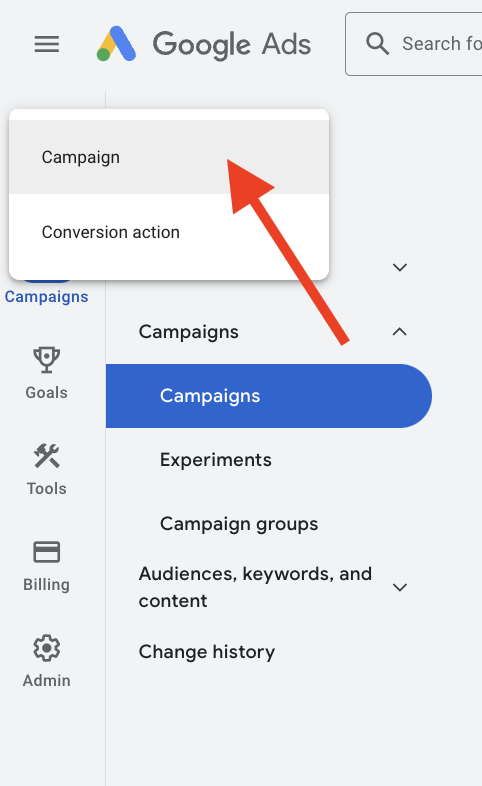
Step 2: Create A New Campaign
Click the “+ New Campaign” button on your dashboard. Choose your campaign objective based on your goals (e.g., “Sales” for driving purchases or “Leads” for collecting customer information). This ensures your DSAs match your business objectives.
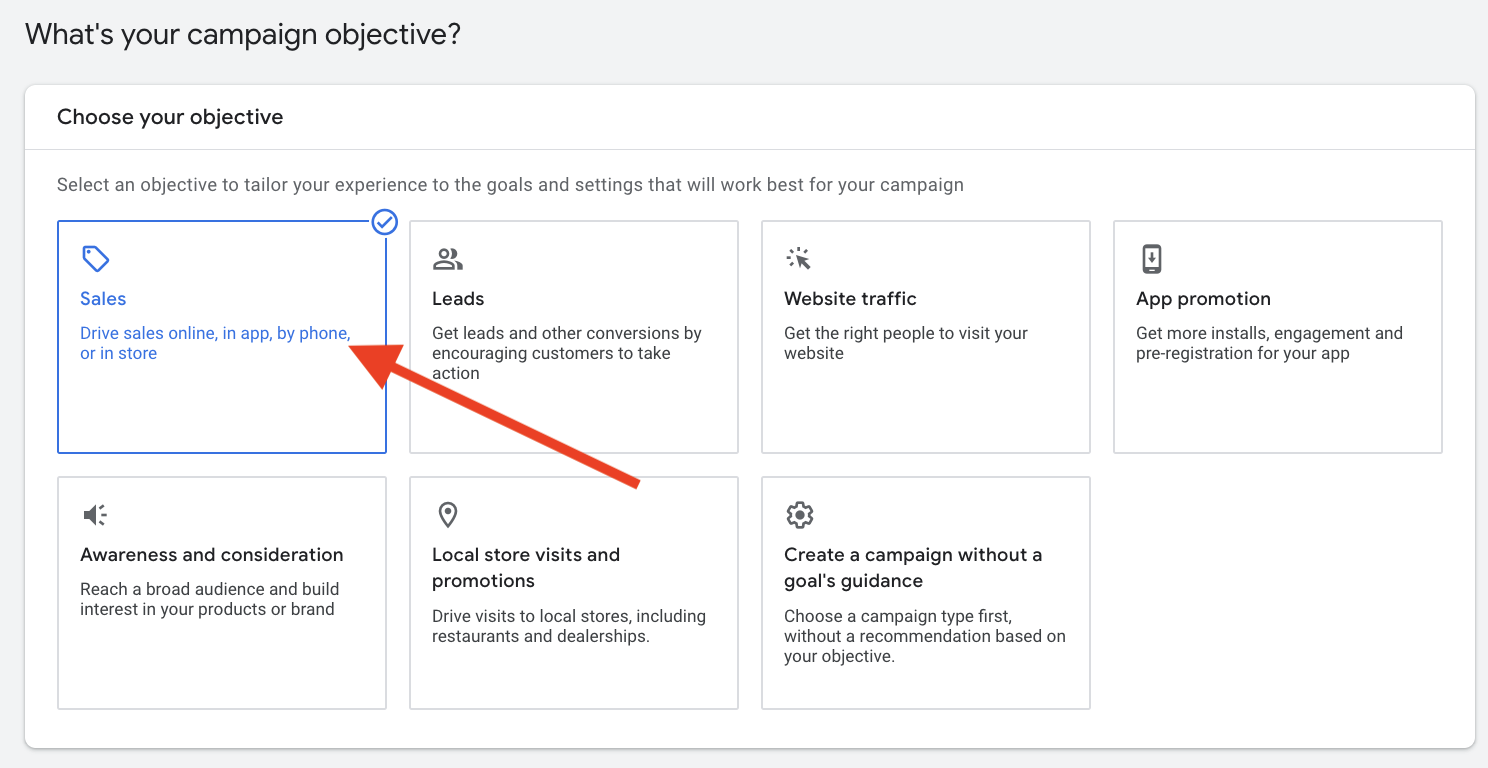
Step 3: Choose Dynamic Search Ads
Under “Campaign Settings,” check the box to “Enable Dynamic Search Ads.” Enter your website domain, ensuring it matches the site you want to advertise. Then, select the appropriate language for your website.
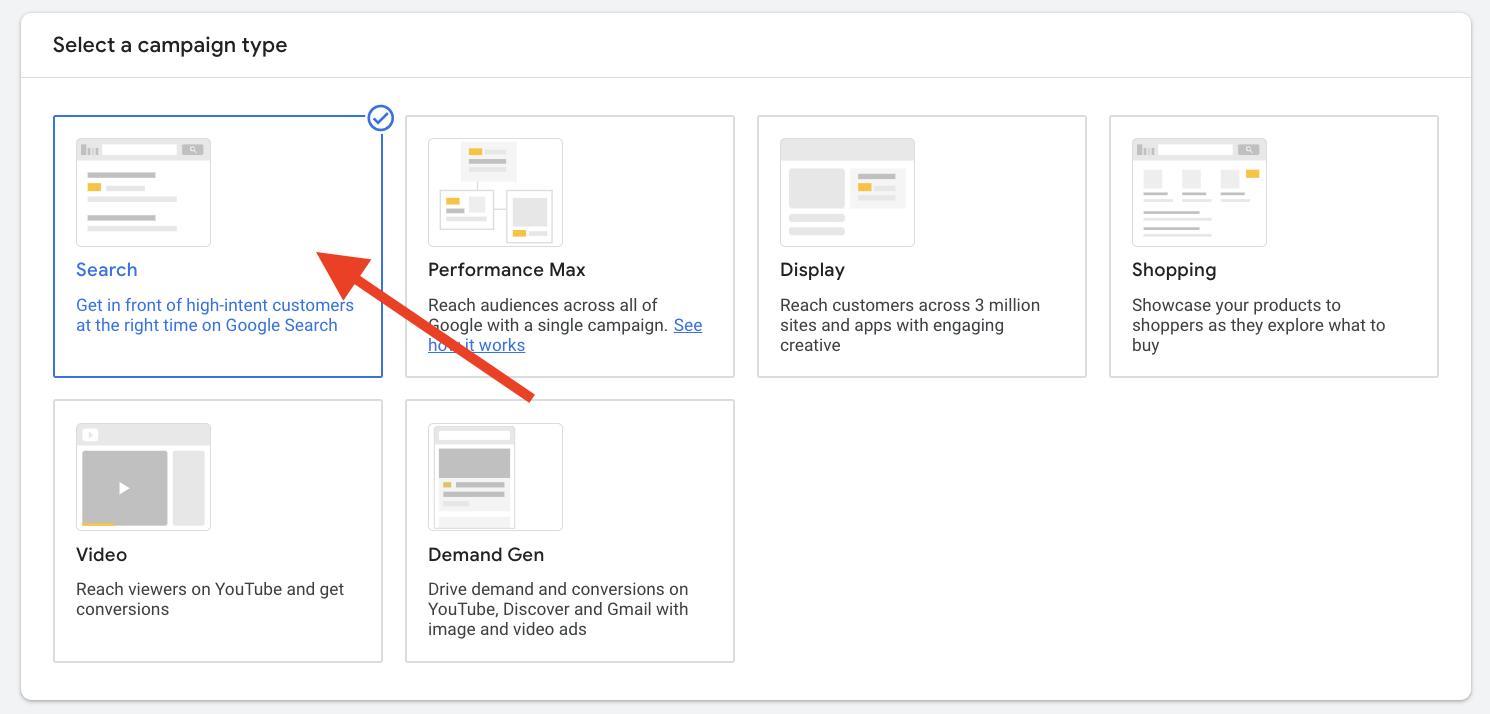
Step 4: Set Up Ad Groups
Create an ad group by selecting the “Dynamic ad group” option. Name the group and then choose how you want to target your ads. It could be all web pages, specific URLs, categories, or page content.
You can target your most valuable pages or categories. For example, target high-converting product pages or popular service categories to maximize the impact of your DSAs.
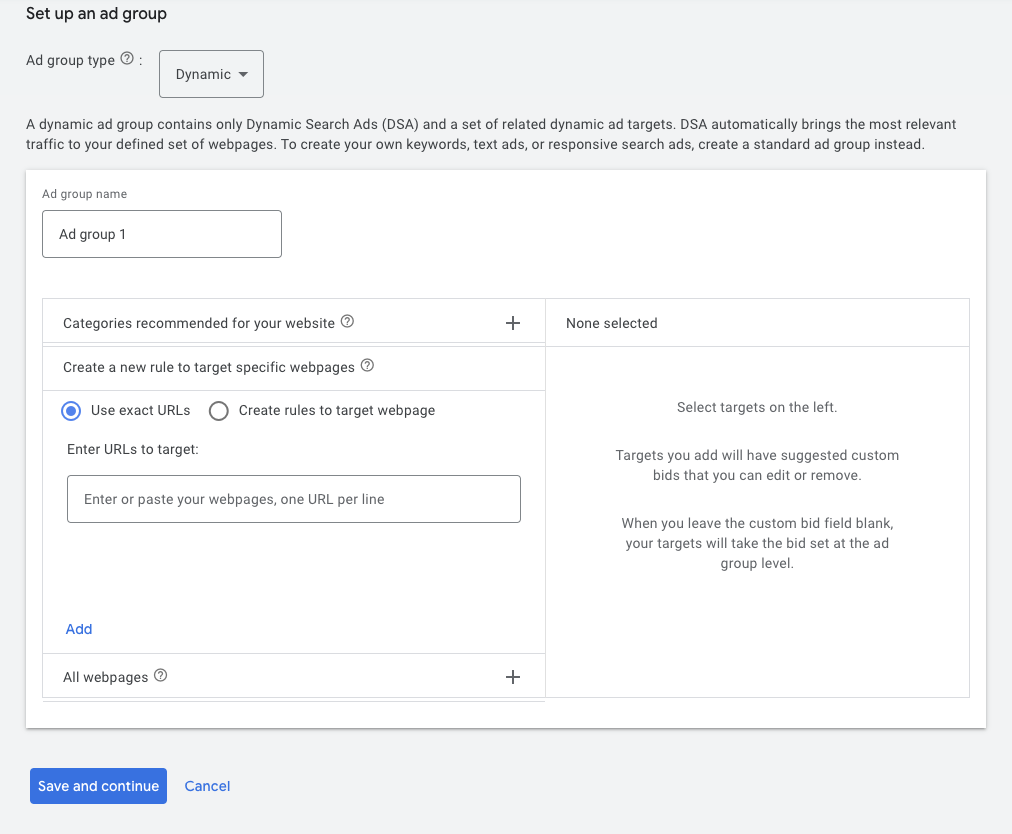
Step 5: Create Your Ads
In the ad creation section, enter compelling description lines that highlight your unique selling points. Google will generate the headlines dynamically based on your website content.
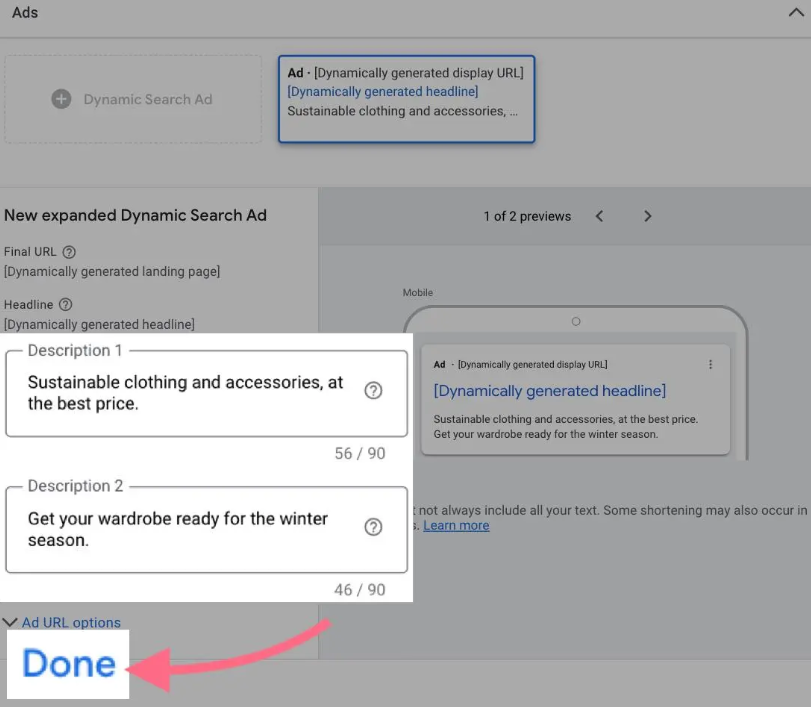
Keep your descriptions concise and action-oriented to ensure Dynamic Search Ads effectively target relevant queries.
Step 6: Set Your Bids & Budget
Choose a bidding strategy that aligns with your campaign goals. For example, use Target CPA (Cost Per Acquisition) if you want to acquire customers at a specific cost. Set a daily or monthly budget that you’re comfortable with.
Monitor your budget and adjust bids regularly based on performance. Start with a moderate budget, and increase it as you see positive results.

Step 7: Add Negative Keywords (Optional)
To refine your targeting, go to the “Keywords” section and add negative keywords to exclude irrelevant search terms. This prevents your ads from appearing for queries that aren’t relevant to your offers.
For example, if you’re advertising a category like perfumes for women, you will add negative keywords like “men’s cologne” or “unisex fragrances”.
Step 8: Review & Launch
Double-check all your dynamic search ad settings, including ad text, targeting, bidding strategy, and budget. Make sure everything aligns with your campaign goals. Once satisfied, click “Save and Continue” to launch your DSA campaign.
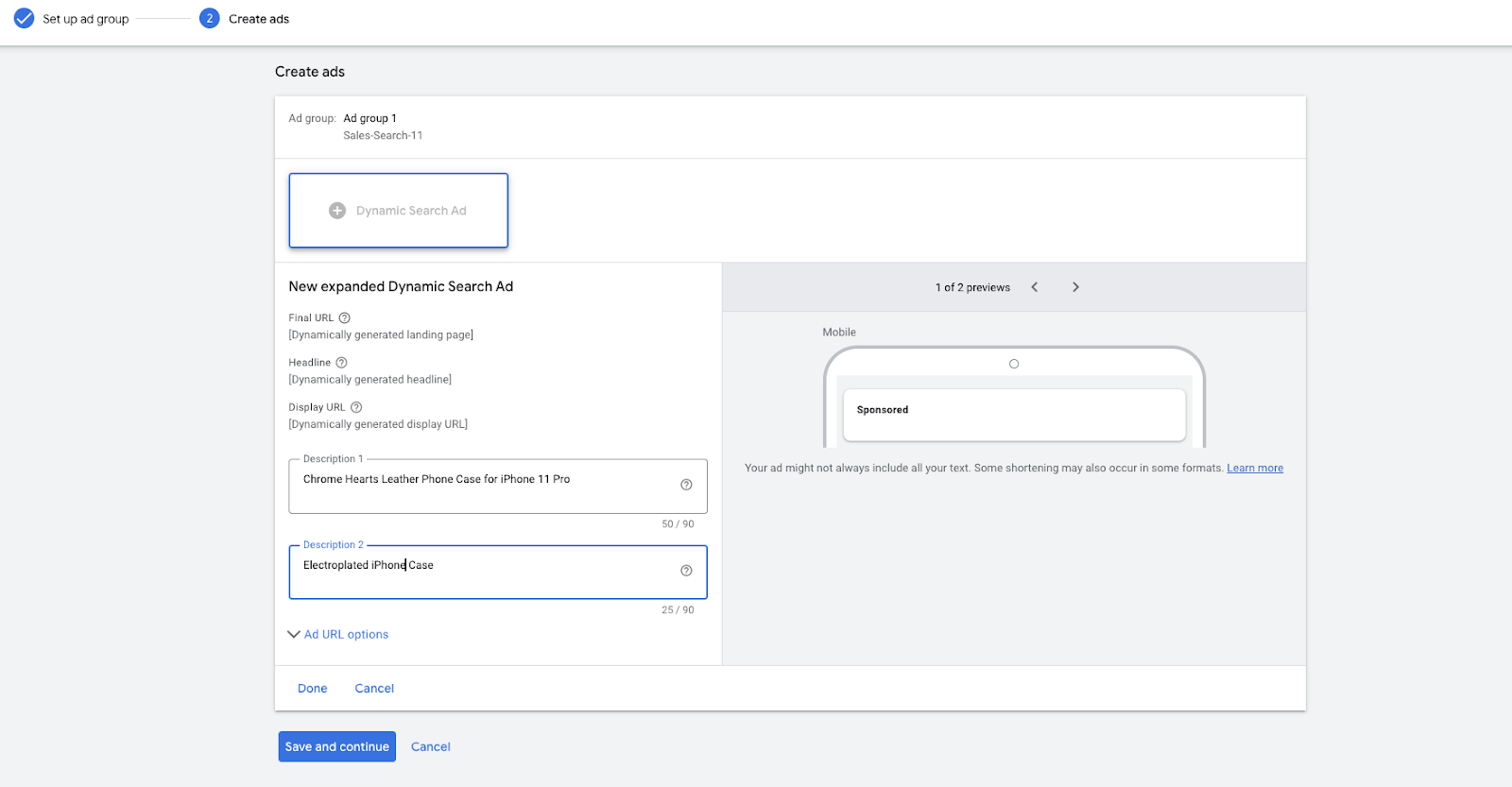
7 Best Practices For Optimizing Dynamic Search Ads
As you apply these strategies, constantly ask yourself: Which of these best practices will have the most immediate impact on improving my ad performance based on my current campaign goals?
a. Choose The Right Pages To Target
Select pages on your website that are most likely to convert. Focus on high-value product or service pages, popular categories, and pages with clear calls to action.
For example, if you’re targeting product categories, your landing pages should be well-optimized with clear product descriptions, high-quality images, and clear calls to action. For us, Vitamart stands out as a prime example of how to do it right. For a business like Vitamart, which operates in the competitive health and wellness industry, targeting the right pages is crucial to attracting the right kind of traffic.
Vitamart has done an exceptional job with its Iron Supplements category page, which has a high potential to convert visitors into buyers. The page is optimized with detailed product descriptions and strong calls to action like “Choose options” and “Add to Cart.” These elements work together to make the purchasing process straightforward and compelling for the customer.
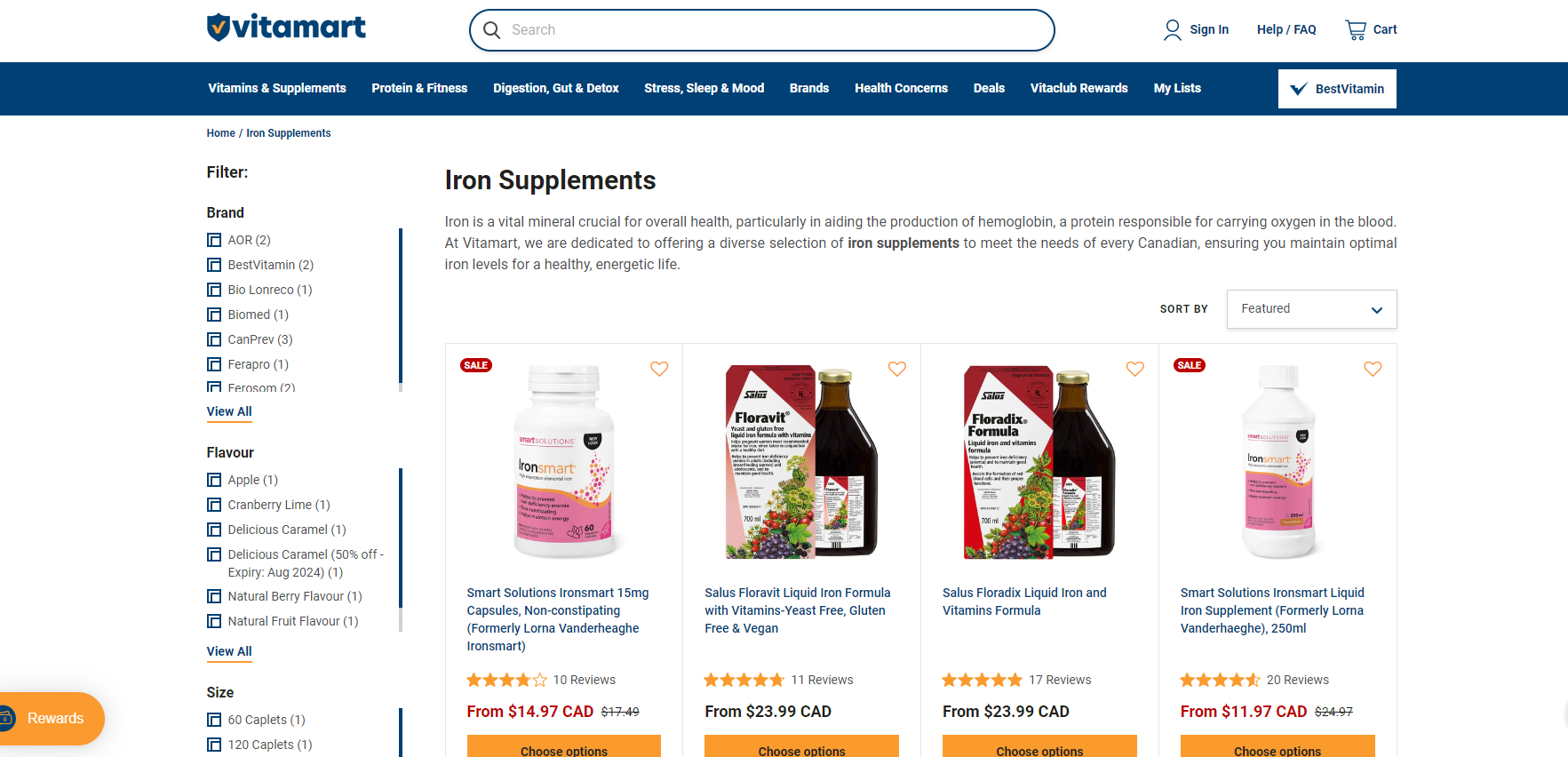
But what really sets Vitamart apart is how they optimized this page for keywords like “iron supplements,” “iron deficiency,” and “best iron pills.” This optimization ensures that Google’s Dynamic Search Ads can easily match the page to relevant search queries to drive highly targeted traffic to the site.
Moreover, focus on categories where you have sufficient inventory to meet potential demand. Running ads for low-stock items will miss opportunities and annoy your customers.
b. Use Ad Extensions
Ad extensions provide additional information alongside your ads like your business location, phone number, or specific product details. Add extensions like Sitelinks, callouts, and structured snippets to improve your click-through rate and stand out on a crowded search results page.
Choose ad extensions based on your website’s needs. For example, if you run a niche-specific retail site, use structured snippets so the customers get detailed product info. Golf Cart Tire Supply sets the gold standard in this context, especially for businesses in niche markets. It has done an incredible job by using ad extensions to provide potential customers with exactly what they need at a glance.
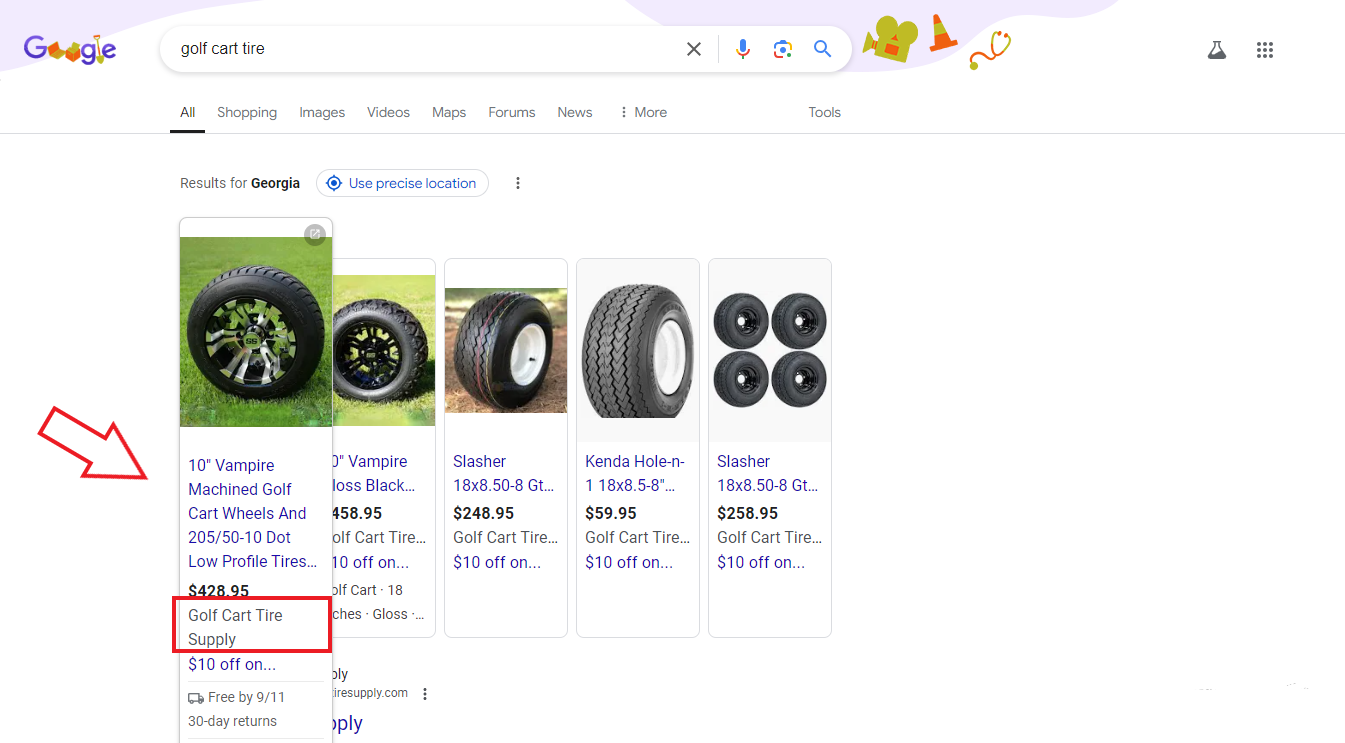
Just look at their Google Dynamic Ads. It perfectly captures the essence of what makes their approach so effective. Their ads are packed with details – everything from the make, model, and size of the tires to the price, images, and even current discounts. This level of detail gives customers all the information they need to make an informed purchase decision right from the search results.
Alternatively, if your website relies on in-person visits, use location extensions. For example, Shay & Blue, which sells perfumes and fragrances, can use location extensions to connect its online presence with in-store experiences. Why is this so important for them? Well, perfume is a sensory product – you can read all about a scent online, but nothing beats smelling it in person.
Shay & Blue knows that their customers want that in-person experience, so they can use location extensions to guide them straight to their stores. This approach can improve their click-through rate but also bridge the gap between digital ads and physical visits, something crucial for a brand like theirs.
Follow these 8 steps to add ad extensions to your Dynamic Search Ads (DSAs):
- Log in to your Google Ads account and navigate to the campaign or ad group where you want to add extensions.
- In the left-hand menu, click on “Ads & extensions” and then select the “Extensions” tab.
- Click the plus (+) button to add a new extension. You’ll see options like Sitelinks, callouts, structured snippets, location, and more. Select the extension type that best suits your campaign goals.
- For Sitelinks, enter the link text, URL, and optional description.
- For callouts, add short, impactful phrases that highlight key benefits or features, like “Free Shipping” or “24/7 Customer Support.”
- For structured snippets, choose a header (like “Services” or “Types”) and list the specific items you want to highlight, such as “Free Returns” or “In-Store Pickup.”
- If you have physical locations, add a location extension by linking your Google My Business account to show your address.
- Once you’ve added the desired extensions, save your changes.
c. Refine Your Ad Copy
While search engines like Google automatically generate headlines for DSAs, you have control over the ad descriptions. Create descriptions that are compelling, relevant, and aligned with the dynamic headlines. Here are 4 key points to create unique and high-performing ad descriptions:
- Keep descriptions short and to the point to focus on the key message.
- Highlight the unique selling points or benefits of your product or service.
- Customize descriptions to match the search query intent and the user’s needs.
- Make sure the descriptions align with the dynamically generated headlines and landing pages.
Make sure your ad descriptions include strong, action-oriented CTAs that encourage clicks and conversions. Phrases like “Shop Now,” “Get a Quote,” or “Learn More” can drive user engagement and improve your click-through rate (CTR).
If you’re finding it challenging to get these details right, hire a marketing expert from a headhunting agency to bring specialized skills and a fresh perspective to your business. They can be especially helpful if you need someone with local knowledge from your target market or if the specific expertise you’re looking for isn’t readily available in your area.
d. Use Negative Keywords Effectively
Negative keywords in DSAs prevent your ads from showing for irrelevant searches. Regularly review search term reports to identify keywords that triggered your ads but didn’t convert, and add these to your negative keyword list.
As your campaign runs, continue to refine your negative keywords list. This ongoing process helps maintain the relevance of your ads and ensures they reach the right audience.
e. Monitor & Adjust Your Bidding Strategy
Consider using automated bidding strategies, like Target CPA (Cost Per Acquisition) or Target ROAS (Return on Ad Spend), to optimize bids based on real-time data.
Here’s how these strategies work:
- Target CPA: Sets a target cost per acquisition and automatically adjusts bids to achieve that goal.
- Target ROAS: Sets a target return on ad spend and automatically adjusts bids to achieve that goal.
These strategies help you achieve your desired outcomes without constant manual adjustments.
Review your campaign performance at least once a week, and adjust bids accordingly. For example, increase bids for high-converting queries or decrease them for low-performing ones. This practice helps you allocate your budget more effectively and maximize your return on investment.
f. Maintain A Clean & Updated Website
Since DSAs rely on your website’s content, keep your site updated. Review and refresh your content every 2 weeks to ensure it’s accurate, relevant, and aligned with current customer needs.
Also, make sure your website is mobile-friendly. With more users searching on mobile devices, having a responsive site can improve your ad’s performance and user experience.
And it’s not just about having a clean and updated website – you also need to keep your audience’s demographics in mind when you’re doing this. Why? Because your website should speak directly to the people who are most likely to visit it.
For example, if your audience skews younger, they’re expecting a modern, mobile-friendly site with more visuals and quick, digestible information, like BuzzFeed‘s approach: short videos, interactive elements, and bold, eye-catching graphics.
On the other hand, if your audience is older, they appreciate larger text, simpler layouts, and clear instructions. Medical Alert Buyers Guide is a fantastic example of doing it right. This site is designed with older adults in mind, and it really shows.

The Medical Alert Buyers Guide features a clean layout and big, easy-to-read fonts that make it super user-friendly. This is especially important for an audience that might be dealing with vision issues or prefers a straightforward, no-fuss experience. They have focused on aesthetics, but they have also ensured that the people who need these products most can find the information they need without frustration.
Follow these 5 easy steps to make your site user-friendly:
- Make sure the text is legible without zooming in.
- Use easy-to-click buttons and a clear menu structure.
- Avoid intrusive pop-ups that can frustrate mobile users.
- Compress images for faster loading on mobile devices.
- Use a responsive design that automatically adjusts the content layout to fit any screen size.
g. Address Privacy Concerns
Make sure your privacy policy clearly explains how you collect and use user data. Always give your users the option to opt out of personalized ads if they prefer to show that you respect their privacy choices. Stay compliant with regulations like GDPR and CCPA to protect your business and your customers.
While privacy is important for every business, it is even more crucial for businesses in the healthcare and medical supply industry like Main Clinic Supply. More than just a legal requirement, it’s a fundamental trust issue because it addresses a core concern for people who are dealing with health-related issues – privacy.
Main Clinic Supply makes it crystal clear that they don’t sell user information. This might sound simple, but it’s a big deal in the healthcare industry. In their privacy policy, they explicitly state that your personal data stays with them and isn’t shared with others for profit. This transparency is key because people want to know that their sensitive information, especially related to health, is safe and won’t be misused.
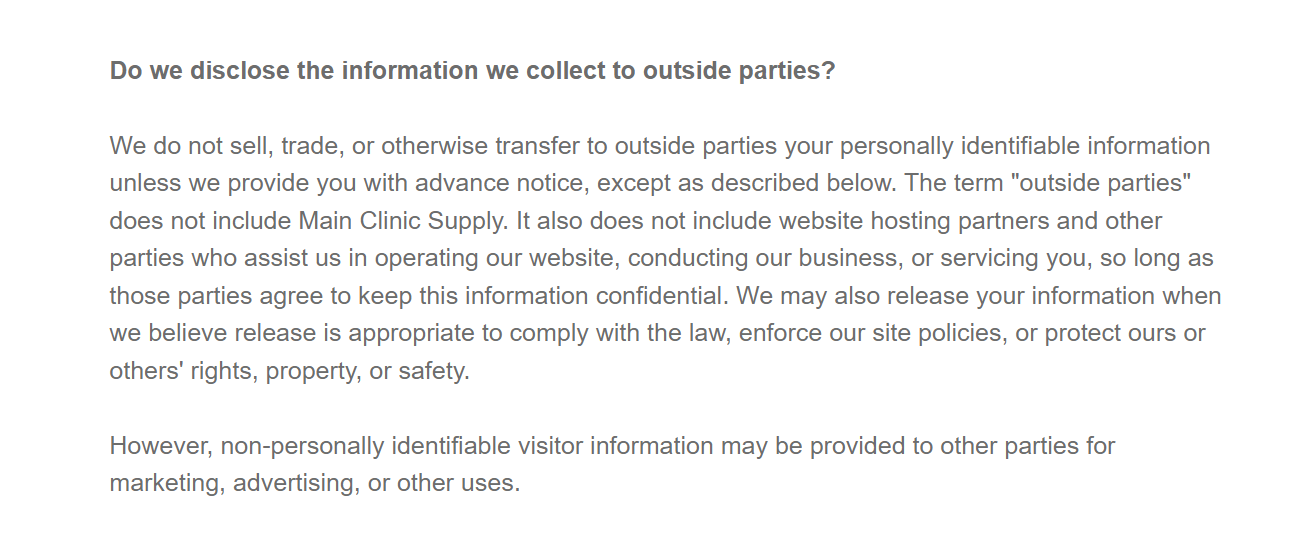
Guidelines can often be wordy and overwhelming, so break them down into bullets or tables. Escort Radar has done an incredible job with this. What sets them apart is how they’ve broken down their privacy guidelines into a simple, easy-to-read table.
Instead of overwhelming users with long paragraphs, they clearly outline the purpose of data collection, the types of data they collect, and the legal basis for processing it. It’s all there in one place which makes it very easy for users to find exactly what they’re looking for.
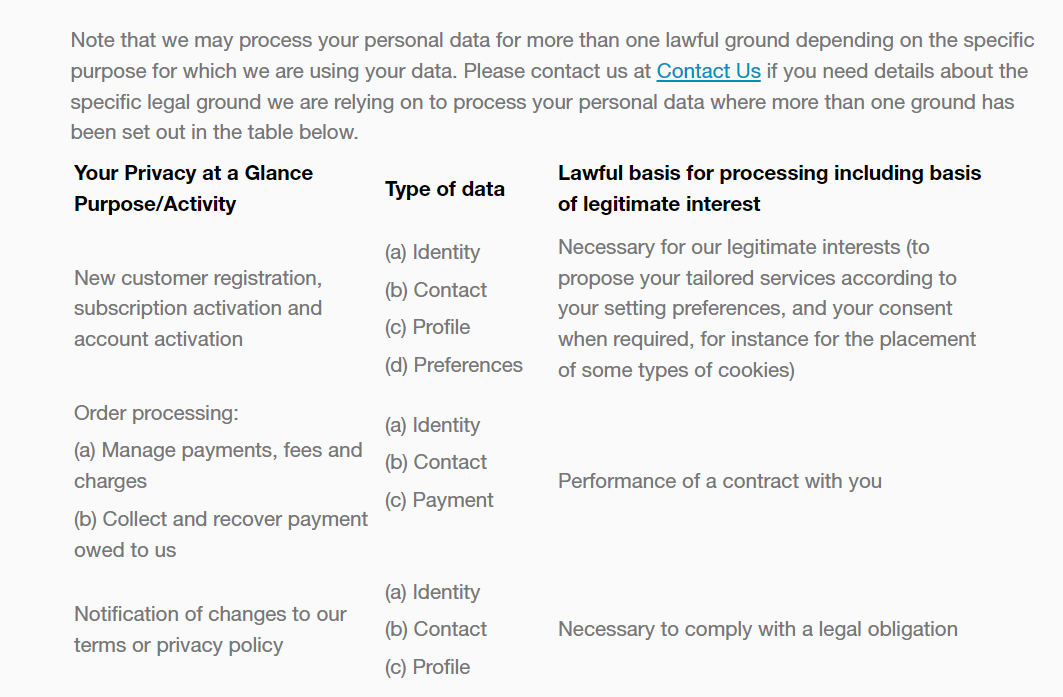
This approach is brilliant because it respects the user’s time and intelligence. Escort Radar understands that users want to know how their data is being used, but they don’t want to sift through a novel to get the answers.
5 Reasons Why Dynamic Search Ads Are Essential for Your 2024 Strategy
With 74% of marketers planning to increase their Google Ads budgets in 2024, leveraging DSAs can help you stay competitive. Let’s find out how DSAs are essential for your 2024 marketing strategy.
I. Targeting Made Easy
DSAs ensure your ads are shown to potential customers who are actively searching for products or services like yours, even if you haven’t identified those exact keywords. This broad yet precise targeting helps you capture more qualified traffic with less effort.
II. Time-Saving Automation
One of the biggest challenges in digital advertising is the time-consuming task of keyword research, ad copy creation, and continuous campaign management. DSAs alleviate much of this burden by automating these processes. Dynamic Search Ads campaigns save time for eCommerce store owners in 5 ways:
- DSAs automatically generate relevant keywords based on your website content.
- DSAs use your product titles, descriptions, and other content to create ad copy.
- DSAs automatically generate dynamic headlines tailored to user queries.
- DSAs continuously track and optimize ad performance.
- With DSAs, setting up a campaign is quick and straightforward, so you can get your ads running faster compared to traditional search ads.
III. Adaptability To Changing Content
Dynamic Search Ads (DSAs) ensure your ads are always up-to-date with your latest offers and the evolving needs of your audience. DSAs keep your campaigns current in 4 ways:
- Whenever you add or modify products or services, DSAs automatically update your ads to reflect these changes, so your audience always sees the most relevant information.
- If you offer seasonal products, like Christmas ornaments, DSAs will automatically generate ads for related keywords during the holiday season.
- As search trends shift, DSAs adjust your ads to match new keywords people are using.
- DSAs continuously learn from user interactions, making data-driven adjustments to enhance your ad performance over time.
IV. Complements Existing Search Campaigns
Here are 4 ways Dynamic Search Ads (DSAs) complement existing search campaigns:
- DSAs fill in gaps by targeting relevant search queries that your keyword-based shopping campaigns might miss.
- DSAs help you reach a broader audience without the need for exhaustive keyword lists, automatically generating ads for your site content.
- DSAs provide valuable data on search terms that perform well, which you can then incorporate into your traditional campaigns for improved targeting.
- DSAs can help identify high-performing areas of your site that weren’t previously targeted, so you can allocate your budget more effectively across all campaigns.
V. Cost-Effective Advertising
Since DSAs match ads directly to the most relevant content on your site, you’re more likely to attract high-quality traffic that converts. With DSAs, you’ll need less manual oversight, which helps you cut down on the costs of managing large-scale campaigns.
FAQs
What’s the difference between Dynamic Search Ads & Responsive Search Ads (RSAs)?
DSAs automatically generate ads based on your website’s content, while RSAs rely on predefined keywords and user-provided headlines and descriptions. DSAs are ideal for broad, automated targeting, whereas RSAs offer more control over ad messaging by testing different combinations to optimize performance.
What is the best bidding strategy for Dynamic Search Ads?
The best bidding strategy for Dynamic Search Ads (DSAs) depends on your specific goals, but Target CPA (Cost Per Acquisition) and Target ROAS (Return on Ad Spend) are highly effective options. Target CPA helps you drive conversions at a specific cost per action – ideal for acquiring new customers within a budget.
Target ROAS optimizes bids to achieve a specific return on your ad spend, which is perfect if you want to maximize revenue from your DSAs. Both strategies use Google’s machine learning to automatically adjust bids and get the most value from your campaigns.
How do I edit Dynamic Search Ads?
To edit your Dynamic Search Ads (DSAs), log in to Google Ads. Access the Google Ads campaigns you want to modify. Start by adjusting the “Dynamic ad targets” under the “Ad groups” tab, where you can refine the pages or categories your ads target.
Next, update the ad descriptions in the “Ads & Extensions” section to ensure they’re relevant and compelling. You can revise your bidding strategy in the “Settings” tab, and add negative keywords in the “Keywords” section to filter out irrelevant searches.
How do I switch off Dynamic Search Ads?
To switch off Dynamic Search Ads (DSAs), follow these 6 steps:
- Log in to your Google Ads account.
- Go to the “Campaigns” tab and select the campaign with DSAs you want to turn off.
- In the “Ad groups” tab, find the ad group associated with your DSAs.
- Click the status toggle next to the ad group and select “Pause.” This will stop the DSAs within that specific ad group from running.
- If you prefer to stop DSAs entirely, go to the “Dynamic ad targets” section in the ad group. You can remove or pause specific dynamic ad targets to disable DSAs.
- Make sure the ad group or dynamic ad targets show as “Paused” or “Removed” to confirm they are no longer active.
How do I create a Dynamic Search Ad in Microsoft ads?
Follow these 10 steps to create your Dynamic Search Ad (DSA) in Microsoft Advertising:
- Log in to your Microsoft Advertising account
- Click on “Create Campaign” from your dashboard.
- Choose your campaign objective (e.g., “Visits to my website” or “Conversions in my website”).
- In the campaign setup, when asked for the campaign type, choose “Search.”
- Under the ad group type, select “Dynamic Search Ads.”
- Name your ad group and enter your website domain. Microsoft Advertising will use your domain to generate dynamic ads.
- Under “Ad targets,” you can choose to target based on specific URLs, categories, or page content.
- Enter the ad text, including the description lines. Microsoft will automatically generate headlines based on the content of your website.
- Choose your bidding strategy (e.g., manual CPC, enhanced CPC) and set your bids.
- Click “Save and launch” to start your Dynamic Search Ad campaign.
Conclusion
As you implement these strategies, ask yourself: What specific content on your website could be optimized to better connect with the search queries your audience is using? It will help you refine your dynamic search ads campaign and ensure they remain relevant and effective in capturing the right audience.
Want to get personalized solutions that drive more relevant traffic and improve ad efficiency? Visit SEO Hero. Our team of professional digital marketers will perform comprehensive site audits to enhance the performance of your dynamic search ads and overall digital marketing efforts. Contact us today to transform your search strategy.




